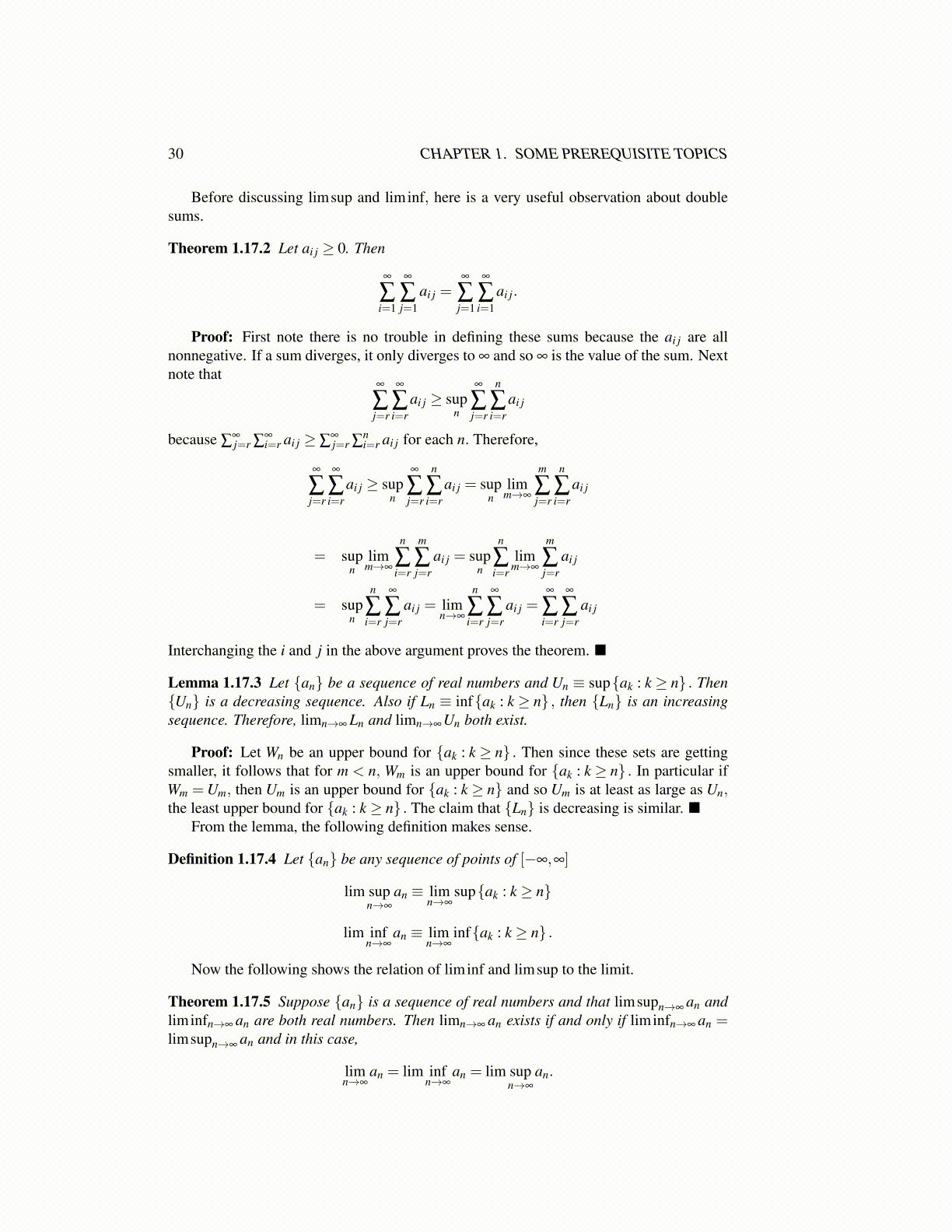
30 CHAPTER 1. SOME PREREQUISITE TOPICS
Before discussing limsup and liminf, here is a very useful observation about doublesums.
Theorem 1.17.2 Let ai j ≥ 0. Then
∞
∑i=1
∞
∑j=1
ai j =∞
∑j=1
∞
∑i=1
ai j.
Proof: First note there is no trouble in defining these sums because the ai j are allnonnegative. If a sum diverges, it only diverges to ∞ and so ∞ is the value of the sum. Nextnote that
∞
∑j=r
∞
∑i=r
ai j ≥ supn
∞
∑j=r
n
∑i=r
ai j
because ∑∞j=r ∑
∞i=r ai j ≥ ∑
∞j=r ∑
ni=r ai j for each n. Therefore,
∞
∑j=r
∞
∑i=r
ai j ≥ supn
∞
∑j=r
n
∑i=r
ai j = supn
limm→∞
m
∑j=r
n
∑i=r
ai j
= supn
limm→∞
n
∑i=r
m
∑j=r
ai j = supn
n
∑i=r
limm→∞
m
∑j=r
ai j
= supn
n
∑i=r
∞
∑j=r
ai j = limn→∞
n
∑i=r
∞
∑j=r
ai j =∞
∑i=r
∞
∑j=r
ai j
Interchanging the i and j in the above argument proves the theorem. ■
Lemma 1.17.3 Let {an} be a sequence of real numbers and Un ≡ sup{ak : k ≥ n} . Then{Un} is a decreasing sequence. Also if Ln ≡ inf{ak : k ≥ n} , then {Ln} is an increasingsequence. Therefore, limn→∞ Ln and limn→∞ Un both exist.
Proof: Let Wn be an upper bound for {ak : k ≥ n} . Then since these sets are gettingsmaller, it follows that for m < n, Wm is an upper bound for {ak : k ≥ n} . In particular ifWm =Um, then Um is an upper bound for {ak : k ≥ n} and so Um is at least as large as Un,the least upper bound for {ak : k ≥ n} . The claim that {Ln} is decreasing is similar. ■
From the lemma, the following definition makes sense.
Definition 1.17.4 Let {an} be any sequence of points of [−∞,∞]
lim supn→∞
an ≡ limn→∞
sup{ak : k ≥ n}
lim infn→∞
an ≡ limn→∞
inf{ak : k ≥ n} .
Now the following shows the relation of liminf and limsup to the limit.
Theorem 1.17.5 Suppose {an} is a sequence of real numbers and that limsupn→∞ an andliminfn→∞ an are both real numbers. Then limn→∞ an exists if and only if liminfn→∞ an =limsupn→∞ an and in this case,
limn→∞
an = lim infn→∞
an = lim supn→∞
an.